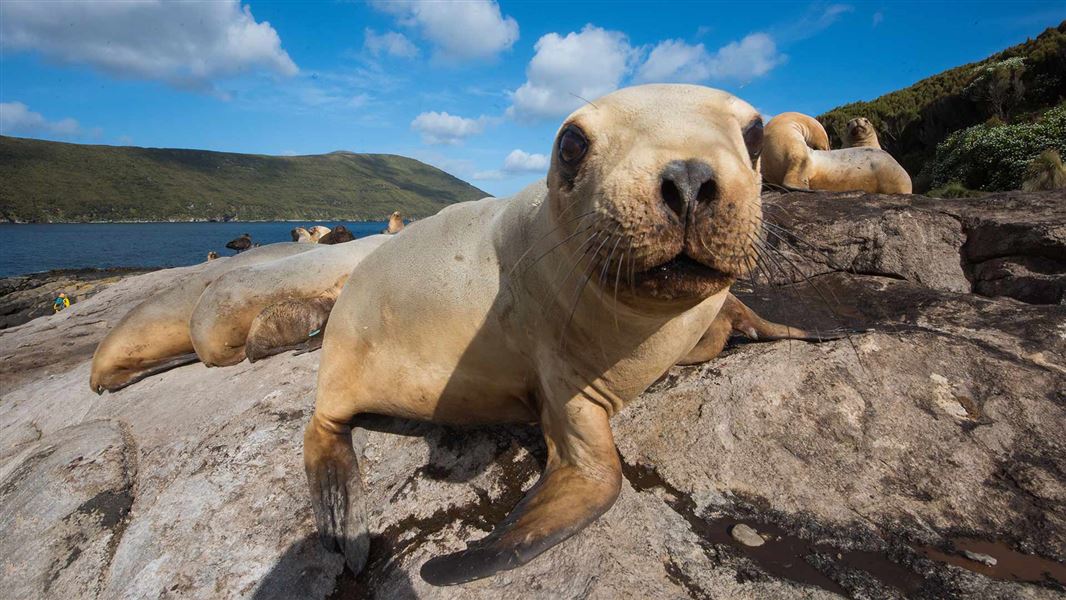We're working at four breeding locations to support the New Zealand sea lion Threat Management Plan (TMP) 2017-2022. These locations are the Auckland Islands/Motu Maha and Campbell Island/Motu Ihupuku in the subantarctic, the Otago and Southland coast of Te Waipounamu, and Stewart Island/Rakiura. The NZ Sea Lion Trust also supports research on New Zealand sea lion.
Download our fieldwork reports and research from our Cerberus site:
View details of our work at each breeding location, on other projects and on the principles we integrate into our work.
Mātauranga Māori
The New Zealand sea lion TMP is an overarching 5-year strategic programme of work agreed to by the Ministers of Conservation and Primary Industries.
The principles of mātauranga Māori are incorporated into the workstreams of the TMP to achieve its goals. Working in partnership on issues relating to sea lions, DOC and the Ministry for Primary Industries enable whānau, hapū, and iwi to fulfil their kaitiakitanga responsibilities towards sea lions.
Auckland Islands/Motu Maha
The TMP goal for the Auckland Islands is that pup production continues to increase from the 2014 count.
We'll evaluate the outcome of our work by measuring:
- improvement of the NZ sea lion adult female and pup survival rates, and
- pup numbers rising consistently above 1,575 (the 2014 pup count), and ideally over the 2017 count of 1,965.
Reports and research findings
Intermittent observations and monitoring at the Auckland Islands occurred between 1942 and 1994. Since then, pup counts have been measured every year at four breeding locations: Enderby Island at Sandy Bay and South East Point, Dundas Island and Figure of Eight Island.
Download our fieldwork reports and presentations by year.
Latest pup counts
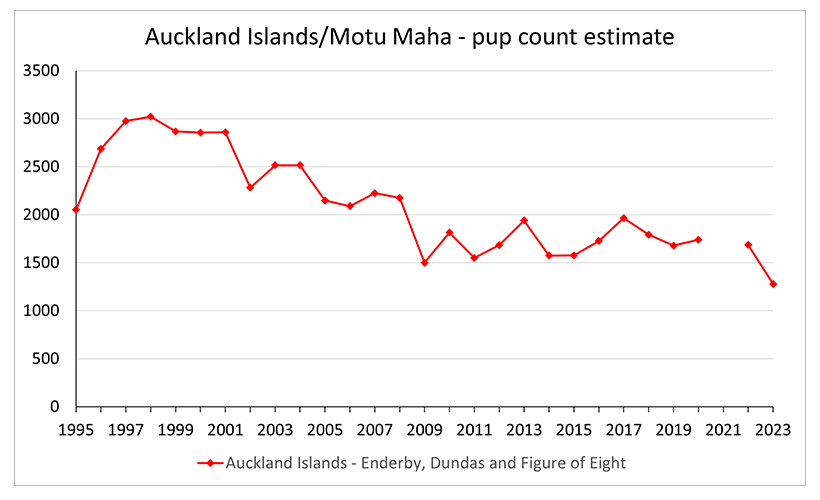
NZ sea lion pup count estimates at the Auckland Islands/Motu Maha
Campbell Island/Motu Ihupuku
The TMP goal for Campbell Island is to reduce the level of pup mortality and support population growth.
We’ll evaluate the outcome of our work by measuring:
- pup counts consistently at or above the 2015 pup count of 696,
- pup mortality rates consistently lower than 40% each year, and
- increased frequency and consistency of sea lion monitoring.
Research and report findings
Opportunistic surveys and ad-hoc tagging of sea lions have taken place on the island since the mid-1950s. Scientific monitoring and rigorous pup counts and tagging of the sea lion population started with an initial structured search and pup tagging in 1998, and surveys were then conducted every 2 to 5 years thereafter. Annual monitoring was conducted at Campbell Island in 2017/18–2019/20.
Download our fieldwork reports and presentations by year.
Latest pup counts
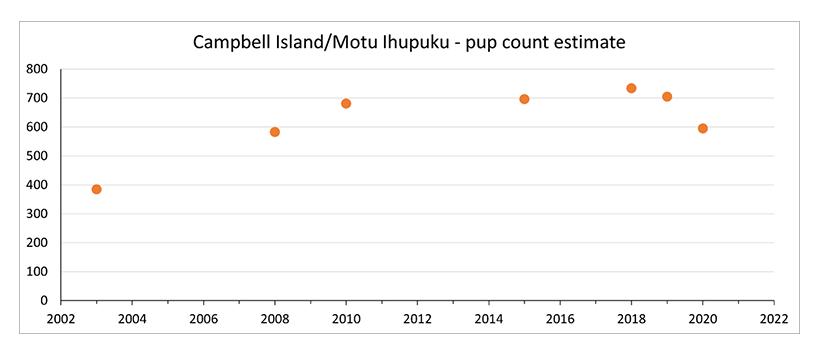
NZ Sea lion pup count estimates at Campbell Island/Motu Ihupuku
Otago and Southland/Te Waipounamu
The TMP goal for Otago and Southland coast is to support population growth.
We'll evaluate the outcome of our work by measuring:
- pup counts above 16 per year, with an aim to reach 35 so this area will be on track to achieve the status of a breeding colony,
- no cases of mortality deliberately caused by humans, and
- increased involvement of the public in conservation of sea lions.
Research and report findings
NZ sea lions were once found along the entire New Zealand coastline, but pressure from sealers and hunters removed breeding colonies from the New Zealand mainland by the 1800s.
In 1993, a female sea lion named “Mum” had her pup at the Otago Peninsula, and this was the first New Zealand sea lion breeding event on the mainland in over 100 years.
Female sea lions are philopatric, which means they return to breed where they were born. So, this event started the recolonisation of the New Zealand sea lion historical breeding range as Mum's female pups continued to breed along the Otago coast.
The New Zealand Sea Lion Trust, local communities, and DOC have been monitoring the New Zealand sea lion population on the mainland, carrying out annual pup counts and tagging.
Download our fieldwork reports and presentations by year.
Latest pup counts
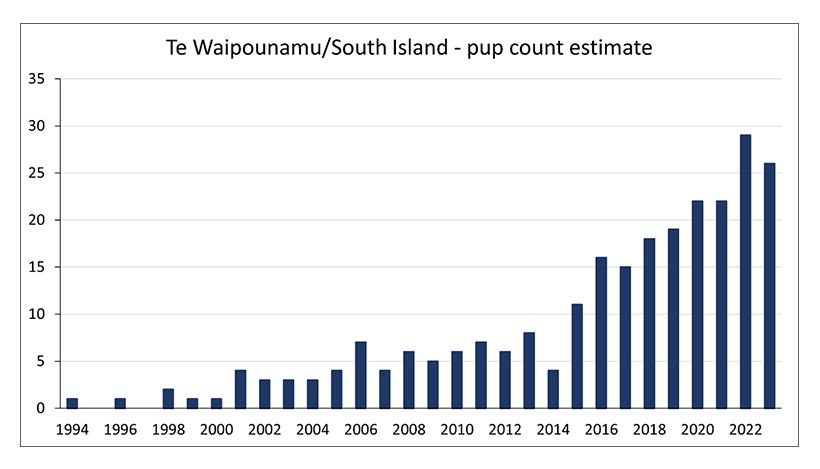
NZ sea lion pup count estimates on the South Island of New Zealand (Te Waipounamu)
Stewart Island/Rakiura
On Stewart Island the TMP goal is to facilitate population growth so the island can achieve breeding colony status.
We'll evaluate the outcome of our work by measuring:
- pup counts higher than 35 for 5 years in a row. This will qualify Stewart Island/Rakiura as a new breeding colony.
- continued increase in number of pups born to enable colonial breeding behaviour
- No deliberate human-caused mortality
- Increased public interest and involvement in the conservation of sea lions.
Research and report findings
Sea lions have been reported around Stewart Island/Rakiura since the mid-1950s. Surveys by University of Otago students in the 1990s recorded the presence of sea lions, including some pups, particularly around Port Pegasus. Since 2011, annual searches have taken place in Port Pegasus in early March and all pups found have been tagged.
Download our fieldwork reports and presentations by year.
Latest pup counts
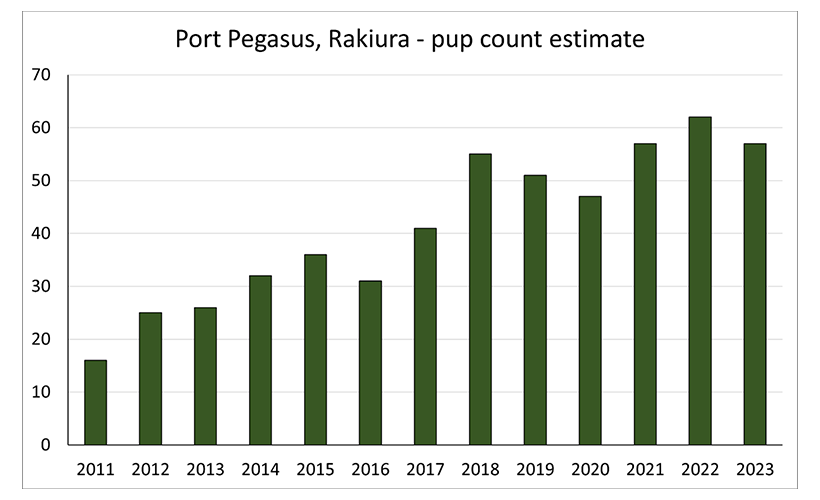
NZ sea lion pup count estimates at Port Pegasus, Stewart Island/Rakiura
